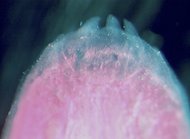birds are toothless dinosaurs, unless they mutate
An interesting story on ScienceNOW is reporting on some cool new genetics research with birds. Researchers in Germany and Wisconsin looked at a mutation in chickens that affects the process of embryonic development. The mutation in the gene called talpid2 usually kills the chickens after a couple of weeks of development, but right at the end of those couple of weeks the researchers found some interesting protrusions on the tip of the jaw. Teeth, specifically conical teeth shaped like those of an alligator. Or a dinosaur.
 Some further work figured out that the mutation was affecting where a gene with the amusing name sonic hedgehog (yes, after the video game) is expressed. Normally that gene is active along the sides of the jaws of chickens, but these mutated chicks had the gene active at the tip of the jaw, where the teeth were.
Some further work figured out that the mutation was affecting where a gene with the amusing name sonic hedgehog (yes, after the video game) is expressed. Normally that gene is active along the sides of the jaws of chickens, but these mutated chicks had the gene active at the tip of the jaw, where the teeth were.Birds are, of course, closely related to dinosaurs. The fossil record is becoming clearer every year as to the process by which small feathered chicken-like dinosaurs developed wings and the other properties of birds, thanks to some great discoveries in China. A very recent Chinese discovery, of a small tyrannosaur-like dinosaur with a crest on its head, has helped paleontologists piece together a pretty decent family tree of tyrannosaurs, birds, and a number of more obscure relatives. Carl Zimmer at the blog The Loom has a good writeup. Here's that family tree, as constructed by Tom Holtz of the University of Maryland:

Birds are the remaining descendents of the fourth branch from the left. Along the way, those quasi-dinosaur quasi-birds lost their teeth. Or rather, as shown by the mutation research, turned off the switch that would cause them to grow teeth.
I find the complexity of the sort of gene expression and embryonic development that leads to chicken embryos with teeth quite remarkable. Mutations in one gene, talpid2, cause the activity of another gene, sonic hedgehog, to change in such a way that a genetic capability that birds used to have, dormant for many millions of years, the capability to grow teeth, is at least partially restored. Who knows what weird stuff is hidden dorment in our DNA?
Labels: science






0 Comments:
Post a Comment
Subscribe to Post Comments [Atom]
<< Home